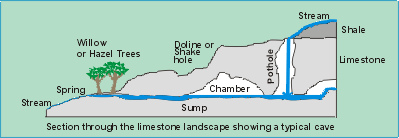
What is a cave?
A cave is usually considered to be any naturally formed underground cavity big enough to enter. The term cave is usually used for horizontal passages and where vertical passages are found, the term pothole is more common. A cavern is another term for a cave, but is usually reserved for large chambers. The study of caves is speleology.

Where do caves form?Return
Nearly all caves form by dissolving cavities in limestone (CaCO3) rocks which underlie about half of Ireland's surface. Occasionally, some caves form in marble, quartzite and rarely, other rocks. Sea caves are not formed by chemical action away but are physically eroded by the sea, and are not usually extensive or deep.
Limestone caves are formed by chemical erosion by moving water. Limestone is a permeable rock, which means that water can pass through it. Limestone is also a soluble rock, which means that it will dissolve in rain-water which is a natural dilute solution of carbonic acid. The continual flow of water through the limestone, and the gradual solution of the stone by the water, causes the enlargement of cracks. They eventually become caves over thousands of years. In most limestone areas there are almost no rivers on the surface. Instead, these rivers are found underground flowing through the caves. The river may enter a cave at a swallow hole, often where the river first comes in contact with the limestone, after flowing over a non soluble rock type.
What shape are caves?Return
Caves are found in all shapes and sizes. The shape is controlled by a number of geological factors and many details of the cave's history can be understood by studying the shape of the passage.
Low flat passage formed on horizontal cracks or "bedding planes" between the layers of limestone.
Tall narrow passage formed on vertical cracks or "joints" in the limestone or as a canyon passage cut by a single stream.
Circular passage formed when the water completely fills the passage like a pipe so the water is able to dissolve the rock equally on all sides. These are called phreatic passages.
Keyhole passage formed when a tall, narrow passage develops below phreatic or bedding plane passage. Also known as T-shaped passage.
The location of swallow holes will also influence the type of cave. If the swallow hole is high up on a hillside the water is able to cut quickly down into the limestone and may form a single passage, several kilometres long, which may contain vertical drops or "pitches" where ropes and ladders are necessary. These are often called "pots" or "potholes".
A swallow hole at a low altitude means the water will flow slowly and will often produce a maze of passage within a small area.
Caves vary in age from region to region and it is often difficult to put an exact age on any cave. Caves are a part of the landscape and as such are slowly developing and evolving. Rivers continually cut downwards through the rock, so often the higher parts of the cave are older. Dry or "Fossil" passages are sometimes found, originally formed by the river, but now inactive. They often contain preserved mud and sediments. These may contain important information about the environment outside the cave, when the sediment was deposited, many years ago. Sediments can sometimes be dated to find a minimum age for the cave. Fossil passages often contain beautiful displays of "stalactites and stalagmites." These "formations" can be dated by measuring the decay of tiny amounts of radioactive Uranium in them. Some Irish examples were found to be 70,000 years old. As a general rule, the larger a cave is, the older it is. Over long periods of time the rock will fall from the cave walls making it larger and forming caverns or chambers that may reach 20m high and 50m in diameter.
What is a stalactite ?Return
A stalactite is a downward pointing deposit of calcite hanging from the roof or wall. Stalactites are formed by drops of water that percolate down through cracks in the limestone. The water dissolves the limestone and becomes a calcium solution. When the first water dribbles into the cave the water drop runs down to the end of a projection and hangs there for a short time. It eventually falls but some of the calcium is left behind as a mineral called calcite and this may build up to form a stalactite. They may be many metres in length. Where the drips land, more calcite is deposited and this may build up to form a stalagmite. For many years the Guinness book of records listed a stalactite in County Clare as the longest free hanging stalactite in the world (11.6m). Its true length is nearer 8 metres and it is sadly no longer listed.
Karst is the term for a landscape developed on soluble rock with underground drainage, typically on limestone. The Burren area of Co. Clare is a good example of a karst area, but the name derives from the classical area of Slovenia. Typical features of a karst landscape include caves, dry valleys and dolines. The latter being crater like hollows or closed depressions formed by solution or collapse.
Limestone pavement,
which is well developed in the Burren, is typical of glaciokarst, formed when
glaciers stripped off all soil and weathered rock. The pavement is now characterised
by blocks of limestone (clints) remaining between the expanded joints (grikes).
The surface is fretted and dissolved into a range of small-scale solution
features known collectively as karren.
Return